Lei Ren
SMAR: Soft Modality-Aware Routing Strategy for MoE-based Multimodal Large Language Models Preserving Language Capabilities
Jun 06, 2025Abstract:Mixture of Experts (MoE) architectures have become a key approach for scaling large language models, with growing interest in extending them to multimodal tasks. Existing methods to build multimodal MoE models either incur high training costs or suffer from degraded language capabilities when adapting pretrained models. To address this, we propose Soft ModalityAware Routing (SMAR), a novel regularization technique that uses Kullback Leibler divergence to control routing probability distributions across modalities, encouraging expert specialization without modifying model architecture or heavily relying on textual data. Experiments on visual instruction tuning show that SMAR preserves language ability at 86.6% retention with only 2.5% pure text, outperforming baselines while maintaining strong multimodal performance. Our approach offers a practical and efficient solution to balance modality differentiation and language capabilities in multimodal MoE models.
StreamLink: Large-Language-Model Driven Distributed Data Engineering System
May 27, 2025Abstract:Large Language Models (LLMs) have shown remarkable proficiency in natural language understanding (NLU), opening doors for innovative applications. We introduce StreamLink - an LLM-driven distributed data system designed to improve the efficiency and accessibility of data engineering tasks. We build StreamLink on top of distributed frameworks such as Apache Spark and Hadoop to handle large data at scale. One of the important design philosophies of StreamLink is to respect user data privacy by utilizing local fine-tuned LLMs instead of a public AI service like ChatGPT. With help from domain-adapted LLMs, we can improve our system's understanding of natural language queries from users in various scenarios and simplify the procedure of generating database queries like the Structured Query Language (SQL) for information processing. We also incorporate LLM-based syntax and security checkers to guarantee the reliability and safety of each generated query. StreamLink illustrates the potential of merging generative LLMs with distributed data processing for comprehensive and user-centric data engineering. With this architecture, we allow users to interact with complex database systems at different scales in a user-friendly and security-ensured manner, where the SQL generation reaches over 10\% of execution accuracy compared to baseline methods, and allow users to find the most concerned item from hundreds of millions of items within a few seconds using natural language.
FreeGraftor: Training-Free Cross-Image Feature Grafting for Subject-Driven Text-to-Image Generation
Apr 22, 2025Abstract:Subject-driven image generation aims to synthesize novel scenes that faithfully preserve subject identity from reference images while adhering to textual guidance, yet existing methods struggle with a critical trade-off between fidelity and efficiency. Tuning-based approaches rely on time-consuming and resource-intensive subject-specific optimization, while zero-shot methods fail to maintain adequate subject consistency. In this work, we propose FreeGraftor, a training-free framework that addresses these limitations through cross-image feature grafting. Specifically, FreeGraftor employs semantic matching and position-constrained attention fusion to transfer visual details from reference subjects to the generated image. Additionally, our framework incorporates a novel noise initialization strategy to preserve geometry priors of reference subjects for robust feature matching. Extensive qualitative and quantitative experiments demonstrate that our method enables precise subject identity transfer while maintaining text-aligned scene synthesis. Without requiring model fine-tuning or additional training, FreeGraftor significantly outperforms existing zero-shot and training-free approaches in both subject fidelity and text alignment. Furthermore, our framework can seamlessly extend to multi-subject generation, making it practical for real-world deployment. Our code is available at https://github.com/Nihukat/FreeGraftor.
GenAI for Simulation Model in Model-Based Systems Engineering
Mar 09, 2025Abstract:Generative AI (GenAI) has demonstrated remarkable capabilities in code generation, and its integration into complex product modeling and simulation code generation can significantly enhance the efficiency of the system design phase in Model-Based Systems Engineering (MBSE). In this study, we introduce a generative system design methodology framework for MBSE, offering a practical approach for the intelligent generation of simulation models for system physical properties. First, we employ inference techniques, generative models, and integrated modeling and simulation languages to construct simulation models for system physical properties based on product design documents. Subsequently, we fine-tune the language model used for simulation model generation on an existing library of simulation models and additional datasets generated through generative modeling. Finally, we introduce evaluation metrics for the generated simulation models for system physical properties. Our proposed approach to simulation model generation presents the innovative concept of scalable templates for simulation models. Using these templates, GenAI generates simulation models for system physical properties through code completion. The experimental results demonstrate that, for mainstream open-source Transformer-based models, the quality of the simulation model is significantly improved using the simulation model generation method proposed in this paper.
Collab-Overcooked: Benchmarking and Evaluating Large Language Models as Collaborative Agents
Feb 27, 2025
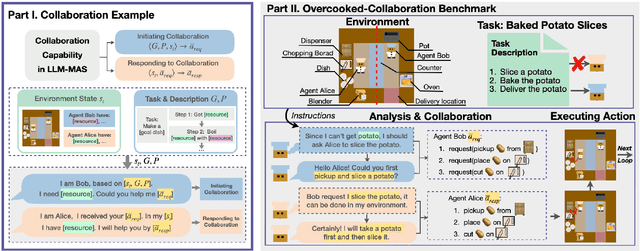

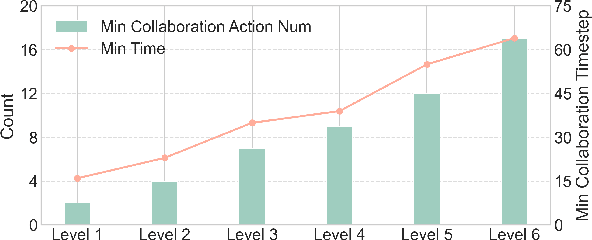
Abstract:Large language models (LLMs) based agent systems have made great strides in real-world applications beyond traditional NLP tasks. This paper proposes a new LLM-powered Multi-Agent System (LLM-MAS) benchmark, Collab-Overcooked, built on the popular Overcooked-AI game with more applicable and challenging tasks in interactive environments. Collab-Overcooked extends existing benchmarks from two novel perspectives. First, it provides a multi-agent framework supporting diverse tasks and objectives and encourages collaboration through natural language communication. Second, it introduces a spectrum of process-oriented evaluation metrics to assess the fine-grained collaboration capabilities of different LLM agents, a dimension often overlooked in prior work. We conduct extensive experiments over 10 popular LLMs and show that, while the LLMs present a strong ability in goal interpretation, there is a significant discrepancy in active collaboration and continuous adaption that are critical for efficiently fulfilling complicated tasks. Notably, we highlight the strengths and weaknesses in LLM-MAS and provide insights for improving and evaluating LLM-MAS on a unified and open-sourced benchmark. Environments, 30 open-ended tasks, and an integrated evaluation package are now publicly available at https://github.com/YusaeMeow/Collab-Overcooked.
AIGC for Industrial Time Series: From Deep Generative Models to Large Generative Models
Jul 16, 2024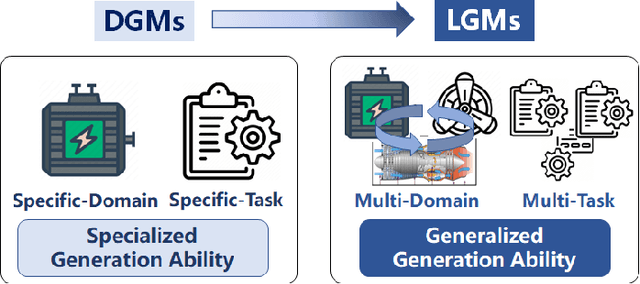
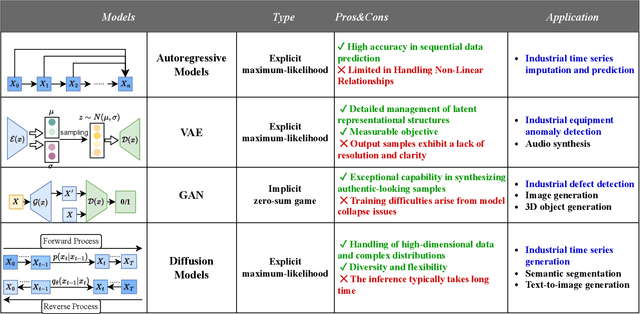
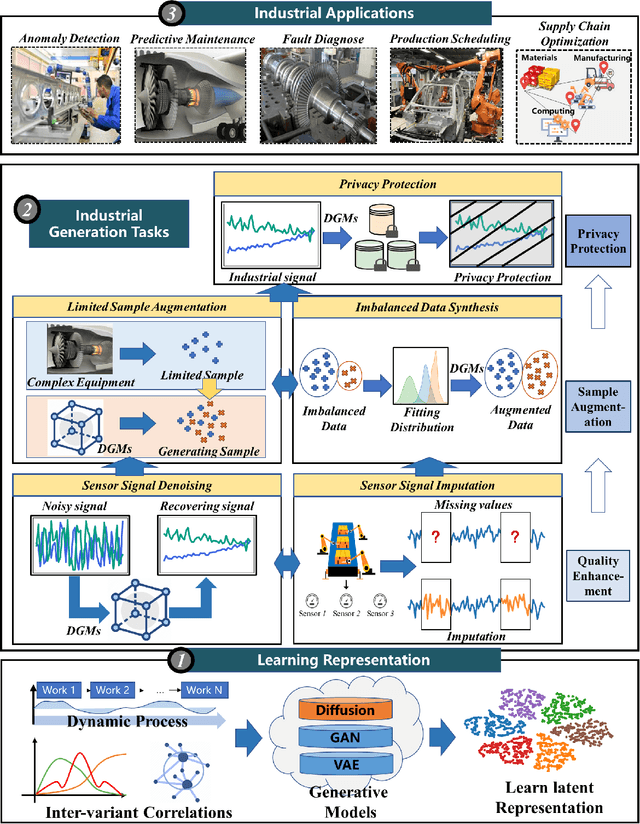
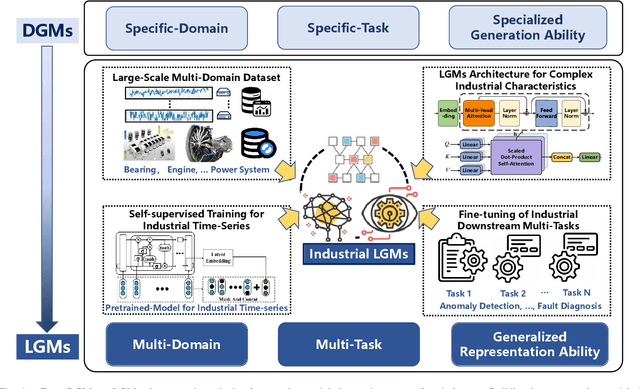
Abstract:With the remarkable success of generative models like ChatGPT, Artificial Intelligence Generated Content (AIGC) is undergoing explosive development. Not limited to text and images, generative models can generate industrial time series data, addressing challenges such as the difficulty of data collection and data annotation. Due to their outstanding generation ability, they have been widely used in Internet of Things, metaverse, and cyber-physical-social systems to enhance the efficiency of industrial production. In this paper, we present a comprehensive overview of generative models for industrial time series from deep generative models (DGMs) to large generative models (LGMs). First, a DGM-based AIGC framework is proposed for industrial time series generation. Within this framework, we survey advanced industrial DGMs and present a multi-perspective categorization. Furthermore, we systematically analyze the critical technologies required to construct industrial LGMs from four aspects: large-scale industrial dataset, LGMs architecture for complex industrial characteristics, self-supervised training for industrial time series, and fine-tuning of industrial downstream tasks. Finally, we conclude the challenges and future directions to enable the development of generative models in industry.
Diff-MTS: Temporal-Augmented Conditional Diffusion-based AIGC for Industrial Time Series Towards the Large Model Era
Jul 16, 2024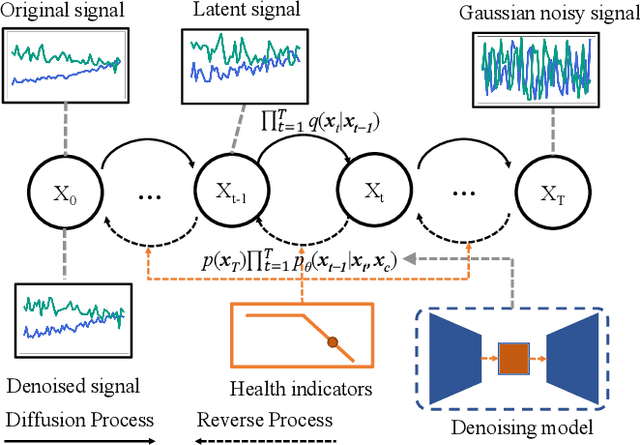
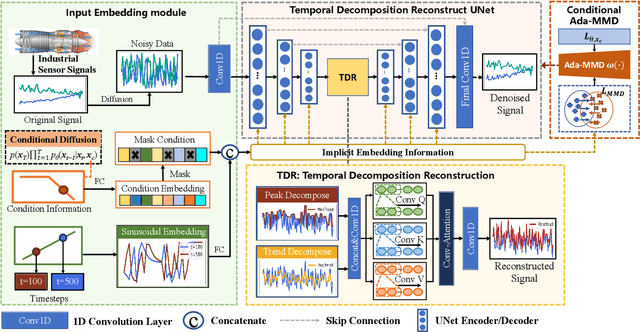
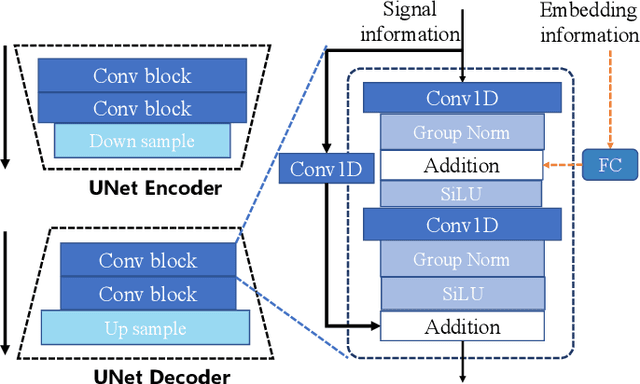
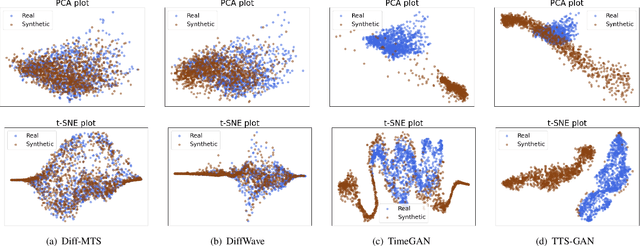
Abstract:Industrial Multivariate Time Series (MTS) is a critical view of the industrial field for people to understand the state of machines. However, due to data collection difficulty and privacy concerns, available data for building industrial intelligence and industrial large models is far from sufficient. Therefore, industrial time series data generation is of great importance. Existing research usually applies Generative Adversarial Networks (GANs) to generate MTS. However, GANs suffer from unstable training process due to the joint training of the generator and discriminator. This paper proposes a temporal-augmented conditional adaptive diffusion model, termed Diff-MTS, for MTS generation. It aims to better handle the complex temporal dependencies and dynamics of MTS data. Specifically, a conditional Adaptive Maximum-Mean Discrepancy (Ada-MMD) method has been proposed for the controlled generation of MTS, which does not require a classifier to control the generation. It improves the condition consistency of the diffusion model. Moreover, a Temporal Decomposition Reconstruction UNet (TDR-UNet) is established to capture complex temporal patterns and further improve the quality of the synthetic time series. Comprehensive experiments on the C-MAPSS and FEMTO datasets demonstrate that the proposed Diff-MTS performs substantially better in terms of diversity, fidelity, and utility compared with GAN-based methods. These results show that Diff-MTS facilitates the generation of industrial data, contributing to intelligent maintenance and the construction of industrial large models.
Density-based Isometric Mapping
Mar 04, 2024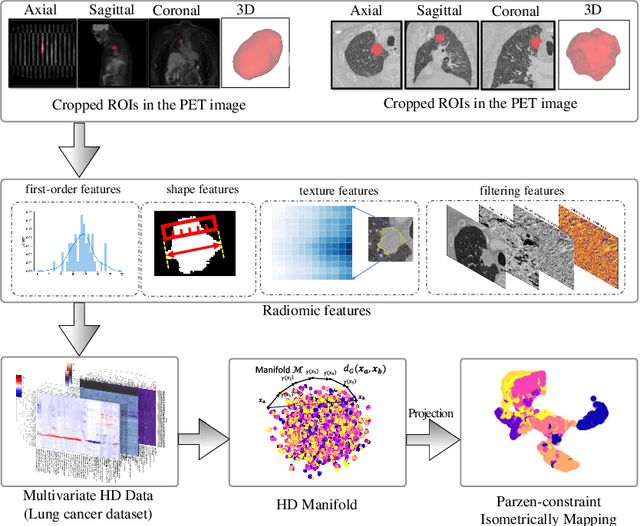
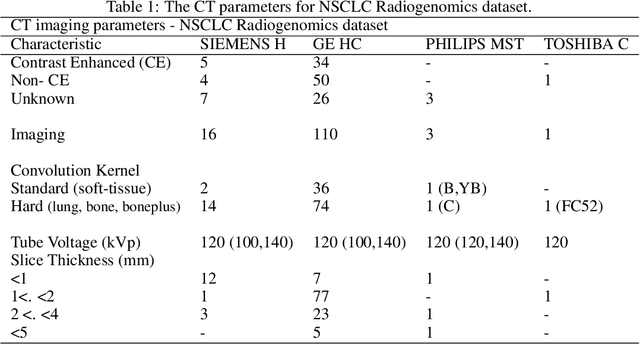
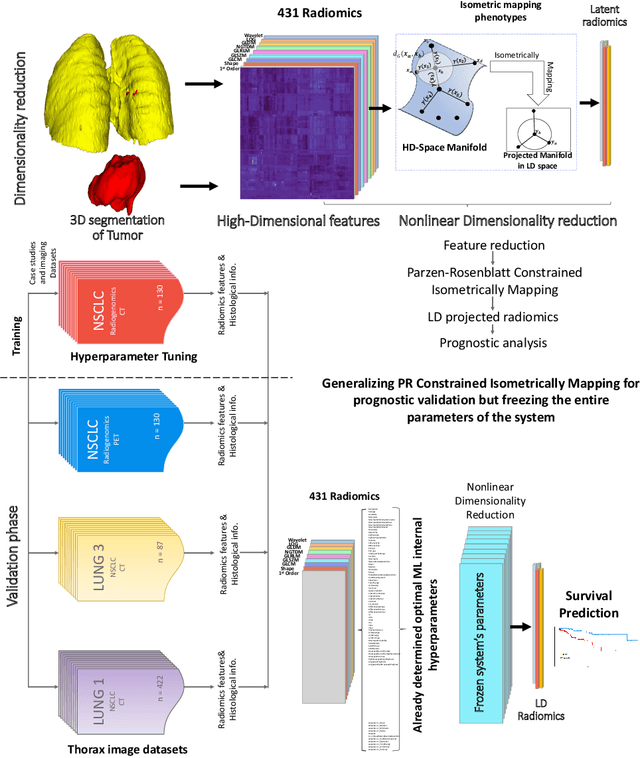
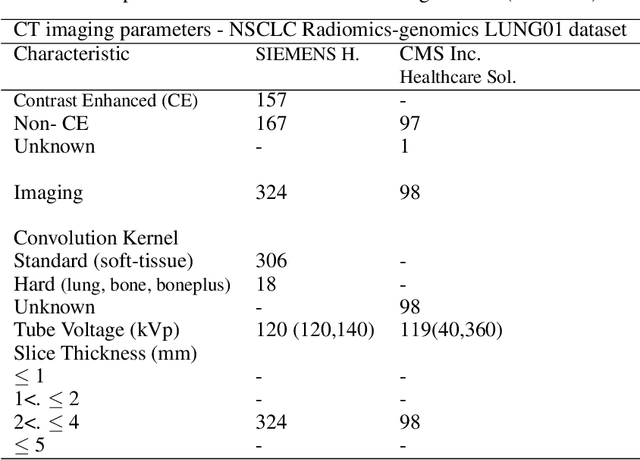
Abstract:The isometric mapping method employs the shortest path algorithm to estimate the Euclidean distance between points on High dimensional (HD) manifolds. This may not be sufficient for weakly uniformed HD data as it could lead to overestimating distances between far neighboring points, resulting in inconsistencies between the intrinsic (local) and extrinsic (global) distances during the projection. To address this issue, we modify the shortest path algorithm by adding a novel constraint inspired by the Parzen-Rosenblatt (PR) window, which helps to maintain the uniformity of the constructed shortest-path graph in Isomap. Multiple imaging datasets overall of 72,236 cases, 70,000 MINST data, 1596 from multiple Chest-XRay pneumonia datasets, and three NSCLC CT/PET datasets with a total of 640 lung cancer patients, were used to benchmark and validate PR-Isomap. 431 imaging biomarkers were extracted from each modality. Our results indicate that PR-Isomap projects HD attributes into a lower-dimensional (LD) space while preserving information, visualized by the MNIST dataset indicating the maintaining local and global distances. PR-Isomap achieved the highest comparative accuracies of 80.9% (STD:5.8) for pneumonia and 78.5% (STD:4.4), 88.4% (STD:1.4), and 61.4% (STD:11.4) for three NSCLC datasets, with a confidence interval of 95% for outcome prediction. Similarly, the multivariate Cox model showed higher overall survival, measured with c-statistics and log-likelihood test, of PR-Isomap compared to other dimensionality reduction methods. Kaplan Meier survival curve also signifies the notable ability of PR-Isomap to distinguish between high-risk and low-risk patients using multimodal imaging biomarkers preserving HD imaging characteristics for precision medicine.
AI-Enabled Lung Cancer Prognosis
Feb 12, 2024Abstract:Lung cancer is the primary cause of cancer-related mortality, claiming approximately 1.79 million lives globally in 2020, with an estimated 2.21 million new cases diagnosed within the same period. Among these, Non-Small Cell Lung Cancer (NSCLC) is the predominant subtype, characterized by a notably bleak prognosis and low overall survival rate of approximately 25% over five years across all disease stages. However, survival outcomes vary considerably based on the stage at diagnosis and the therapeutic interventions administered. Recent advancements in artificial intelligence (AI) have revolutionized the landscape of lung cancer prognosis. AI-driven methodologies, including machine learning and deep learning algorithms, have shown promise in enhancing survival prediction accuracy by efficiently analyzing complex multi-omics data and integrating diverse clinical variables. By leveraging AI techniques, clinicians can harness comprehensive prognostic insights to tailor personalized treatment strategies, ultimately improving patient outcomes in NSCLC. Overviewing AI-driven data processing can significantly help bolster the understanding and provide better directions for using such systems.
* This is the author's version of a book chapter entitled: "Cancer Research: An Interdisciplinary Approach", Springer
Compliant actuators that mimic biological muscle performance with applications in a highly biomimetic robotic arm
Oct 31, 2023Abstract:This paper endeavours to bridge the existing gap in muscular actuator design for ligament-skeletal-inspired robots, thereby fostering the evolution of these robotic systems. We introduce two novel compliant actuators, namely the Internal Torsion Spring Compliant Actuator (ICA) and the External Spring Compliant Actuator (ECA), and present a comparative analysis against the previously conceived Magnet Integrated Soft Actuator (MISA) through computational and experimental results. These actuators, employing a motor-tendon system, emulate biological muscle-like forms, enhancing artificial muscle technology. A robotic arm application inspired by the skeletal ligament system is presented. Experiments demonstrate satisfactory power in tasks like lifting dumbbells (peak power: 36W), playing table tennis (end-effector speed: 3.2 m/s), and door opening, without compromising biomimetic aesthetics. Compared to other linear stiffness serial elastic actuators (SEAs), ECA and ICA exhibit high power-to-volume (361 x 10^3 W/m) and power-to-mass (111.6 W/kg) ratios respectively, endorsing the biomimetic design's promise in robotic development.
 Add to Chrome
Add to Chrome Add to Firefox
Add to Firefox Add to Edge
Add to Edge